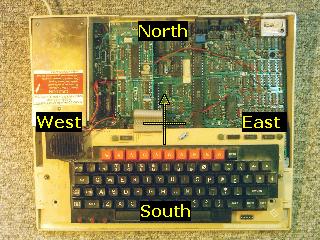Difference between revisions of "Orientation"
m (1 revision) |
m (1 revision) |
(No difference)
| |
Revision as of 01:13, 8 March 2015
Acorn Computer used a standard orientation to locate parts and describe directions on the printed circuit boards of its computers. This would be known to all service personnel and anyone familiar with Acorn hardware.
On the BBC Micro and later 8-bit machines, the standard orientation corresponds to the computer being placed on an opened map, both laid on a desk in the conventional way. North, South, East and West apply to each of the boards inside the computer as well as to the whole unit. Therefore:-
- The North side carries the round sockets, mains cable and power switch.
- The South side carries the keyboard, and the flat IDC sockets underneath.
- The West side is the location of the power supply unit.
- The East side has the RAM and ROM nearby (Model B), and an Aries B20 board would lie against the East side of the case.
- The top of the silkscreen lettering faces North.
- All but two ICs on the motherboard have the half-moon notches facing North. Daughterboards are inserted in IC sockets with Pin 1 at the Northwest corner. However, ICs on the daughterboards may be facing in any direction.
- The serial line driver and receiver ICs, next to the RS423 socket, have the half-moon notches facing West.
- The keyboard cable connects the South side of the motherboard to the North side of the keyboard.
The power supply board in the Model B is mounted upside-down in the enclosure; maintenance guides should define their own orientation to avoid confusion. Also of course, beware of hazardous voltages even when disconnected from the mains.
-- beardo 19:55, 28 September 2006 (BST)
